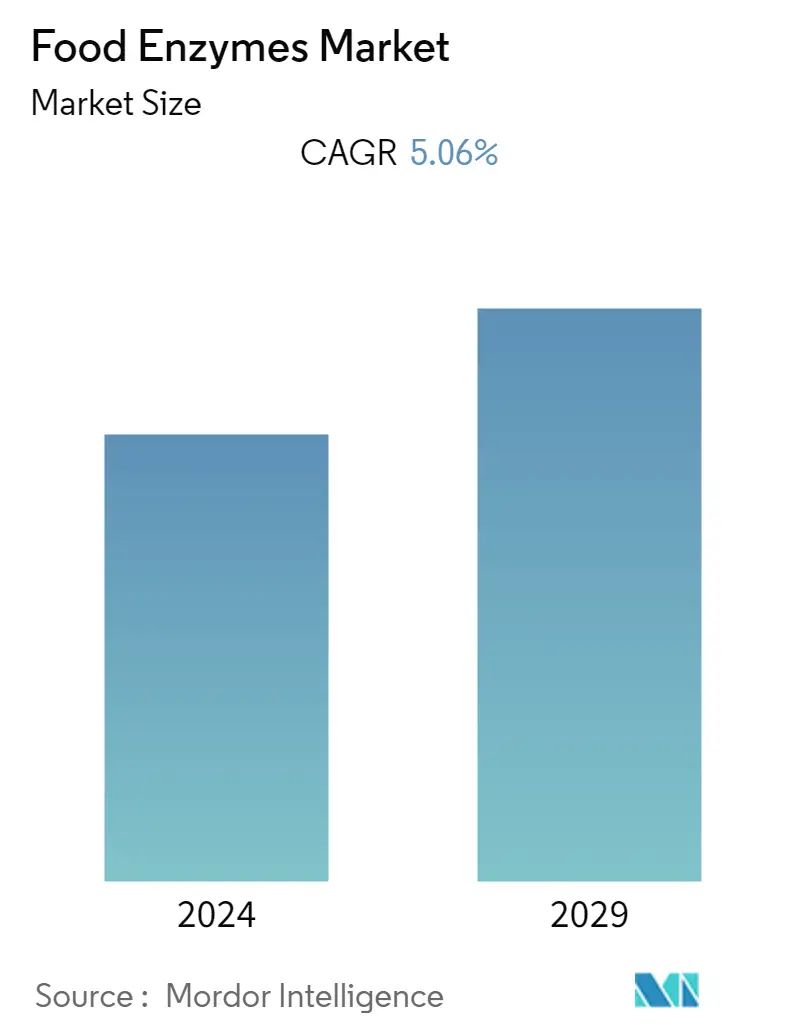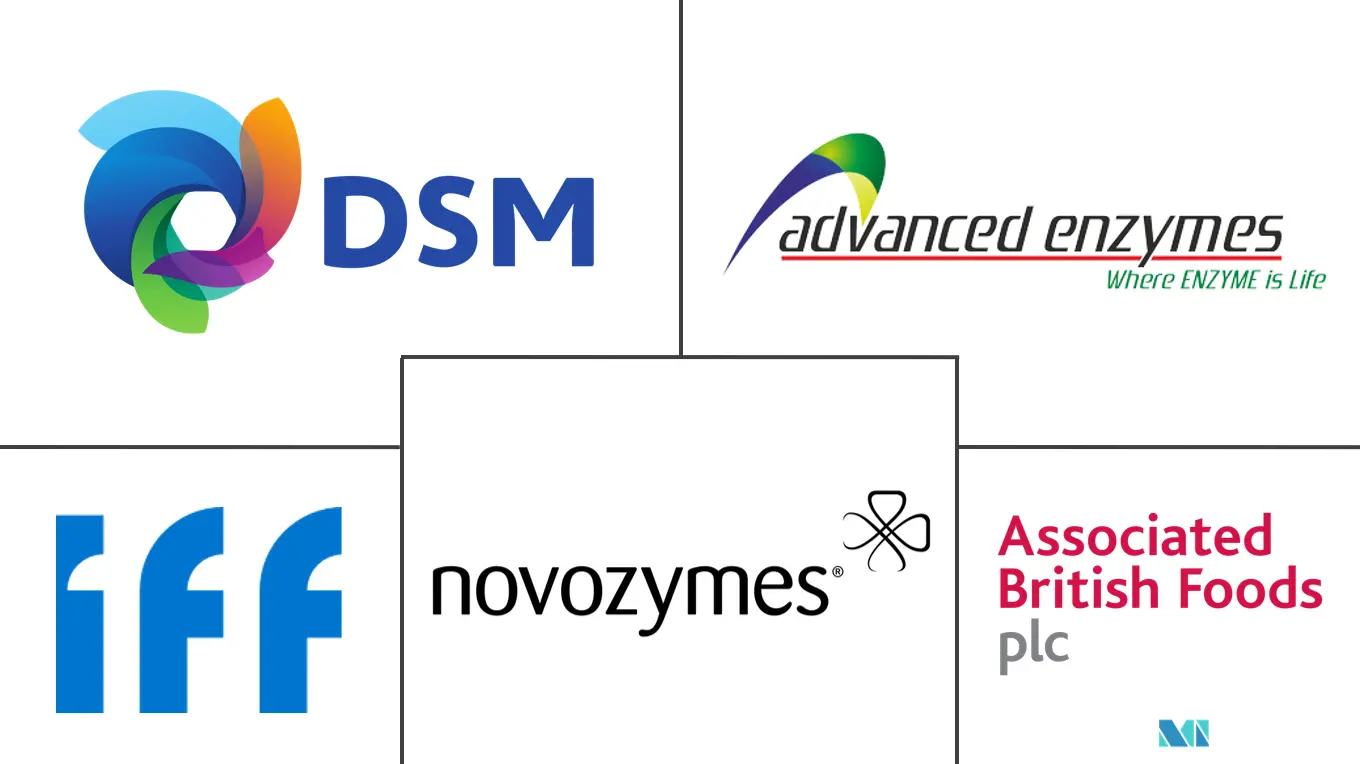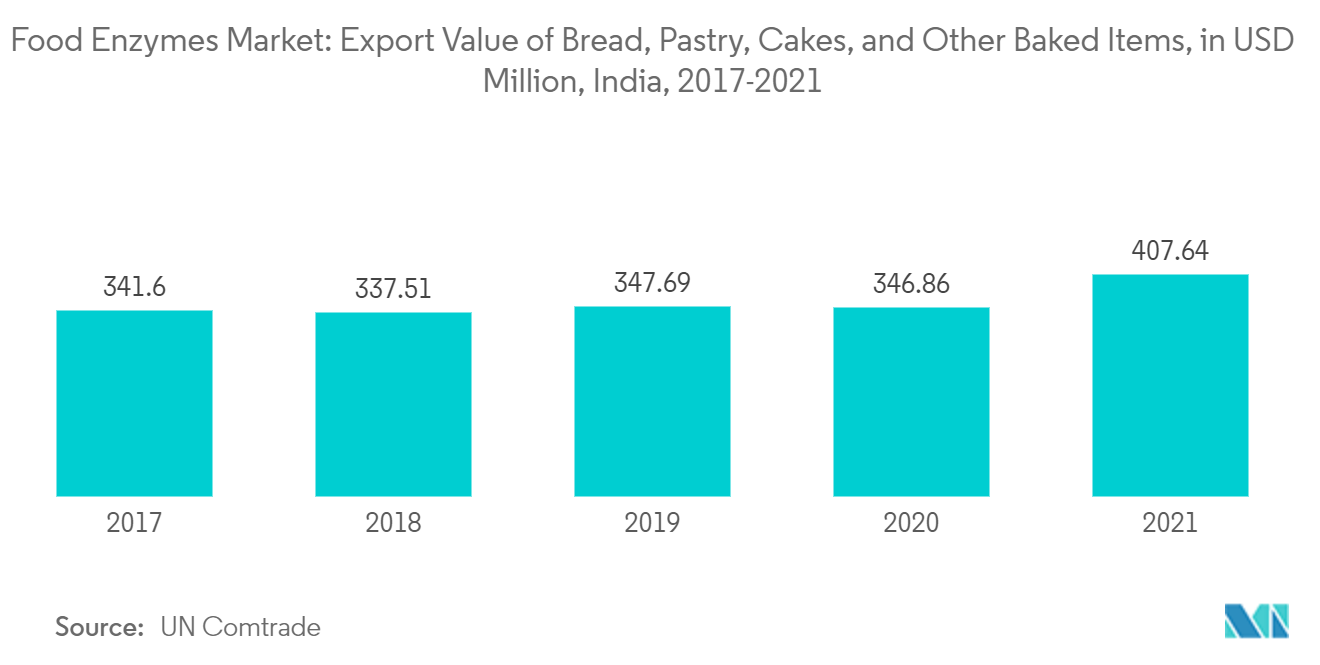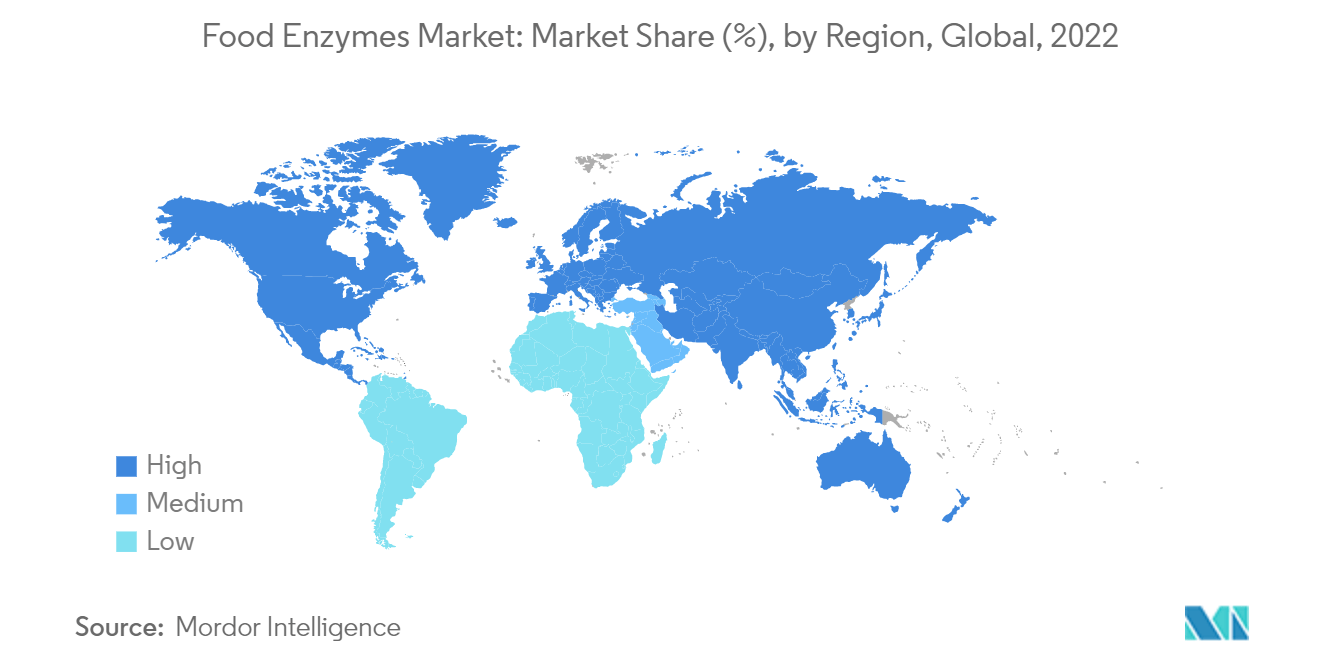Food Enzymes Market Size

| Study Period | 2019 - 2029 |
| Base Year For Estimation | 2023 |
| CAGR | 5.06 % |
| Fastest Growing Market | Asia Pacific |
| Largest Market | North America |
| Market Concentration | Low |
Major Players
*Disclaimer: Major Players sorted in no particular order |
Food Enzymes Market Analysis
The Food Enzymes market is projected to register a CAGR of 5.06% during the forecast period.
The demand for packaged and processed foods is growing with the need to provide food security and safety. However, due to complexities in the global food supply chain, there is a need to add food additives to keep the nutritional content intact and maintain the shelf life. Apart from this, the increasing penetration of organized retail in urban and rural centers globally drives the food enzymes market. The environment-friendly production process, waste reduction and energy saving in the food industry, and increased demand in food industries are driving the market.
Enzymes have a range of applications that include the production of white bread, rye bread, and maize tortillas, and many such trending products. The demand for food enzymes is anticipated to someday surpass that for other industrial enzymes due to the fast expansion of the global food, beverage, and pharmaceutical industries. Owing to the rising demand for various kinds of enzymes, companies either focus on marketing or creating new food enzyme compositions. Additionally, there has been a surge in popularity of vegan diets across the globe for example, in a Choice Australia study from 2021, 63% of participants responded that they believed meals with labeling as "plant-based" were appropriate for vegans. Plant-based foods were more frequently associated by respondents with sustainability, animal friendliness, and health. Enzymes are also used in the manufacturing of vegan products such as alternative dairy products. Hence, Koninklijke DSM N.V., a science-based corporation operating globally in the fields of nutrition, health, and sustainable living, offers the Delvo Plant line of enzymes for enhancing the flavor, consistency, and sweetness of beverages made from plants. These enzymes, which are a part of DSM's growing portfolio of alternatives to dairy products, provide a distinctive range of advantages, from enhancing protein solubility and lowering viscosity to enhancing mouthfeel and releasing the inherent sweetness of raw materials like rice, soy, and oats. The Delvo Plant enzymes are intended to enable marketers to create successful cereal- and non-cereal-based drinks. From such instances, it is evident that the growing scope of enzymes across various fields is anticipated to boost the growth of the market studied.
Food Enzymes Market Trends
Increase of Food Enzyme Usage in Bakery and Beverage Industries
Bakery products consist of several products like bread, pastries, doughnuts, and rolls. Food enzymes act as a catalyst for biochemical reactions that offer quality improvements in bakery products. The bakery is the largest application market for food enzymes. Bakery products are prominent in North America and Western Europe. Asia-Pacific is the fastest-growing region for bakery foods, with Australia, India, and China being the main drivers. In Australia, there is an increase in demand for food enzymes in bakery applications due to restrictions on the use of chemical additives, especially in the manufacture of bread and other fermented products. According to the data from UN Comtrade, the exports of bread, cakes, and other bakery products from India jumped from USD 346.86 million in 2020 to USD 407.64 million in 2021.
The beverage segment comprises food enzyme application in alcoholic and non-alcoholic beverages, with carbohydrase and lipase as the major categories of enzymes. Additionally, in the segment, enzymes provide three major functions- formation of sugar that is used during fermentation, viscosity control, and chill-proofing for beer. In the brewing industry, the major enzymes used include cellulose, alpha-amylase, and beta-glucanase for the liquefaction, clarification, and supplementing of malt enzymes. Some of the key benefits of brewing enzymes include better malt separation, extraction yield, and beer filtration and stabilization.

North America Emerges as the Market Leader
North America is the largest market for enzyme applications in food industries. High consumption of meat and meat products in the region is one of the key factors augmenting the food enzymes market. The United States is the market leader in enzyme production and consumption at the regional and global levels, attributed to increased expenditure on premium quality products and consumer preference for processed foods incorporated with naturally sourced ingredients. The United States is the market leader in enzyme production and consumption in the North American region, followed by Mexico. The great demand is attributed to the increased expenditure on premium quality products by the consumers of the United States, along with the shift in preference for processed foods incorporated with naturally sourced ingredients. One such example of the growth of the enzyme industry across the region includes the growth of the wine industry across the region. Enzymes are widely used to make wines hence, the growth of the wine industry in turn propels the enzyme market. For instance, according to the Wine Institute, the retail sales of wine in the United States in 2021 were about USD 78.4 billion, which was higher when compared to the previous year's sales, which totaled USD 66.8 billion. Technological innovation and up-gradation are other key driving factors for market growth in the country. In addition, rapid urbanization coupled with rising living standards is also anticipated to be the driver for change in consumer tastes and preferences in the United States.

Food Enzymes Industry Overview
The global food enzyme market is highly fragmented in nature, attributed to a large number of players involved in the market. Active companies are involved in new product development, expansion, and acquisition to sustain the market competition. Some major players are expanding their global presence by acquiring manufacturers in foreign countries. The major players in the market include Novozymes A/S, International Flavors & Fragrances Inc., Koninklijke DSM N.V., Advanced Enzyme Technologies Limited, and Associated British Foods plc. Focus on bakery enzymes for gluten-free products, digestive enzymes for dietary supplements, and dairy enzymes are the key focus areas of the company's new product development
Food Enzymes Market Leaders
-
Koninklijke DSM N.V.
-
Novozymes A/S
-
Advanced Enzyme Technologies Limited
-
International Flavors & Fragrances Inc.
-
Associated British Foods plc
*Disclaimer: Major Players sorted in no particular order

Food Enzymes Market News
- In December 2022, Novozymes and Chr. Hansen, producers of enzymes and food ingredients in Denmark announced their plans to merge in order to strengthen their presence in the global enzymes market.
- In February 2021, DuPont's Nutrition and Biosciences Business amalgamated with International Flavors & Fragrances. The combined company continues to operate under the name IFF. The merger solidified IFF's place as one of the most prominent players in the ingredients space.
- In May 2021, Spanish enzyme manufacturer DR Healthcare Espaa was acquired by the AB Biotek Ingredients division of Associated British Foods Plc. Diamine oxidase (DAO), a crucial intestinal enzyme, was added to the company's portfolio as a part of the acquisition, which was anticipated to strengthen AB Biotek's existing robust commercial range of probiotic yeast strains.
Food Enzymes Market Report - Table of Contents
1. INTRODUCTION
1.1 Study Assumptions & Market Definition
1.2 Scope of the Study
2. RESEARCH METHODOLOGY
3. EXECUTIVE SUMMARY
4. MARKET DYNAMICS
4.1 Market Drivers
4.2 Market Restraints
4.3 Porter's Five Forces Analysis
4.3.1 Threat of New Entrants
4.3.2 Bargaining Power of Buyers/Consumers
4.3.3 Bargaining Power of Suppliers
4.3.4 Threat of Substitute Products
4.3.5 Intensity of Competitive Rivalry
5. MARKET SEGMENTATION
5.1 Type
5.1.1 Carbohydrase
5.1.2 Protease
5.1.3 Lipase
5.1.4 Others
5.2 Application
5.2.1 Bakery
5.2.2 Confectionery
5.2.3 Dairy and Frozen Desserts
5.2.4 Meat, Poultry and Sea Food Products
5.2.5 Beverages
5.2.6 Other Application
5.3 Geography
5.3.1 North America
5.3.1.1 United States
5.3.1.2 Canada
5.3.1.3 Mexico
5.3.1.4 Rest of North America
5.3.2 Europe
5.3.2.1 United Kingdom
5.3.2.2 Germany
5.3.2.3 France
5.3.2.4 Italy
5.3.2.5 Spain
5.3.2.6 Russia
5.3.2.7 Rest of Europe
5.3.3 Asia-Pacific
5.3.3.1 China
5.3.3.2 Japan
5.3.3.3 India
5.3.3.4 Australia
5.3.3.5 Rest of Asia-Pacific
5.3.4 South America
5.3.4.1 Brazil
5.3.4.2 Argentina
5.3.4.3 Rest of South America
5.3.5 Middle-East and Africa
5.3.5.1 South Africa
5.3.5.2 United Arab Emirates
5.3.5.3 Rest of Middle-East and Africa
6. COMPETITIVE LANDSCAPE
6.1 Strategies Adopted by Leading Players
6.2 Market Share Analysis
6.3 Company Profiles
6.3.1 Kerry Group PLC
6.3.2 International Flavors & Fragrances Inc.
6.3.3 Koninklijke DSM N.V.
6.3.4 Chr. Hansen Holding A/S
6.3.5 Novozymes A/S
6.3.6 Advanced Enzyme Technologies Limited
6.3.7 Brain AG (Biocatalyst LTD)
6.3.8 Associated British Foods plc
6.3.9 Amano Enzyme Inc.
6.3.10 Lumis Biotech Pvt. Ltd.
- *List Not Exhaustive
7. MARKET OPPORTUNITIES AND FUTURE TRENDS
Food Enzymes Industry Segmentation
Food enzymes are often used for food processing owing to their multiple benefits, which include enhancement of texture, flavor & fragrance, preservation, coagulation, and tenderization. The global food enzymes market is segmented by type, application, and geography. By type, the market is segmented into carbohydrase, protease, lipase, and others. Based on the application, the market is divided into bakery, confectionery, dairy and frozen desserts, meat, poultry, seafood products, beverages, and other applications. The study also covers the global level analysis of the major regions of North America, Europe, Asia-Pacific, South America, and the Middle East & Africa. For each segment, the market sizing and forecasts have been done on the basis of value (in USD Million).
| Type | |
| Carbohydrase | |
| Protease | |
| Lipase | |
| Others |
| Application | |
| Bakery | |
| Confectionery | |
| Dairy and Frozen Desserts | |
| Meat, Poultry and Sea Food Products | |
| Beverages | |
| Other Application |
| Geography | |||||||||
| |||||||||
| |||||||||
| |||||||||
| |||||||||
|
Food Enzymes Market Research FAQs
What is the current Food Enzymes Market size?
The Food Enzymes Market is projected to register a CAGR of 5.06% during the forecast period (2024-2029)
Who are the key players in Food Enzymes Market?
Koninklijke DSM N.V., Novozymes A/S, Advanced Enzyme Technologies Limited, International Flavors & Fragrances Inc. and Associated British Foods plc are the major companies operating in the Food Enzymes Market.
Which is the fastest growing region in Food Enzymes Market?
Asia Pacific is estimated to grow at the highest CAGR over the forecast period (2024-2029).
Which region has the biggest share in Food Enzymes Market?
In 2024, the North America accounts for the largest market share in Food Enzymes Market.
What years does this Food Enzymes Market cover?
The report covers the Food Enzymes Market historical market size for years: 2019, 2020, 2021, 2022 and 2023. The report also forecasts the Food Enzymes Market size for years: 2024, 2025, 2026, 2027, 2028 and 2029.
Food Enzymes Industry Report
Statistics for the 2024 Food Enzymes market share, size and revenue growth rate, created by ����vlog��ý™ Industry Reports. Food Enzymes analysis includes a market forecast outlook to 2029 and historical overview. Get a sample of this industry analysis as a free report PDF download.



